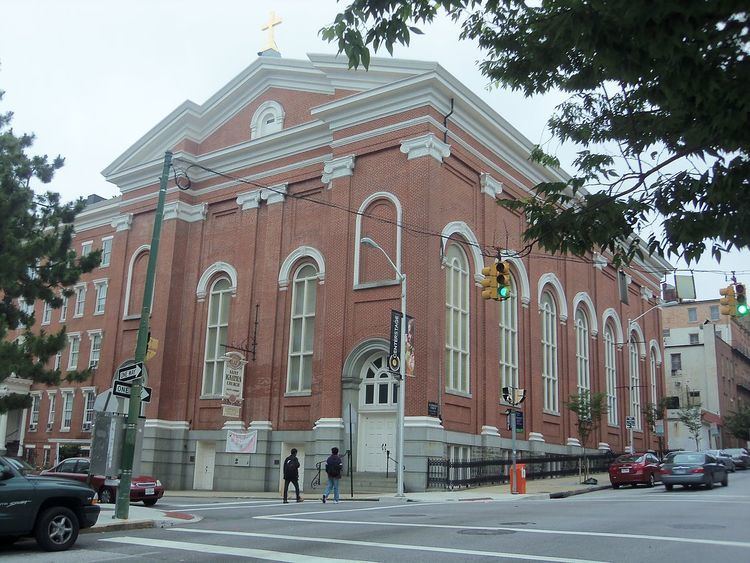Country United States Consecrated 15 August 1856 Phone +1 410-727-3848 | Years built 1853–1856 | |
 | ||
Location 740 North Calvert Street, Baltimore, MD 21202 Address 740 N Calvert St, Balti, MD 21202, USA Similar St Alphonsus Church, St Casimir Church - Balti, St Vincent de Paul Church, St Leo's Church, Holy Rosary Church | ||
St. Ignatius Church is a Jesuit Roman Catholic church located at 740 N. Calvert St in the Mt. Vernon neighborhood of Baltimore, Maryland. Mt. Vernon is located north of downtown Baltimore and is considered the city’s center of history and culture. The church is dedicated to Saint Ignatius of Loyola, the founder of the Society of Jesus (Jesuits).
Contents
History
In 1852, the new Archbishop of Baltimore, Francis Kenrick, asked the local Jesuit Provincial to open a new college in response to petitions from the newly elected, anti-Catholic Know Nothing party to ban Catholic teachings from public schools in Maryland. As a result, Loyola College opened its doors in 1852 and moved to its former location on Calvert and Madison streets in 1855. St. Ignatius Church was originally built to accompany the adjoining Loyola College, at 700 N Calvert, prior to the college’s move in 1922 to an Evergreen Campus in North Baltimore. The church opened on August 15, 1856 on the Feast Day of the Assumption of Mary. On 20 September 1857 the chapel of St Peter Claver was dedicated, where masses were provided for the black population. This congregation in 1864 obtained its own parish church, St. Francis Xavier.
Major renovations were carried out in 1870, the transparent glass windows replaced with new stained glass. New pews to seat about six hundred people were added. A ceiling painting of the Assumption of Mary by Wilhelm Lamprecht was added. The following year, the newly renovated church was decorated for the public celebration of the twenty-fifth anniversary of Pius IX's election to the papacy; gaslight illuminations were installed for the occasion but could not be used because of adverse weather.
In 1968 a series of protests in support of the Catonsville Nine was held at the church.
After World War II the church had seen a sharp drop in the number of parishioners as many city residents moved to the suburbs. This led the church to “refashion their mission and ministry” in the 1990s to bring Catholics back to Mt. Vernon. In 1991, the church underwent a $1.7 million renovation to separate the sanctuary from the entrance to give parishioners a place to gather before and after mass.
Architecture
St. Ignatius Church was built by Louis L. Long, a prominent Baltimore architect, from 1853 to 1856 with the assistance of Henry Hamilton Pittar. The building is in the Italianate style featuring Ionic columns, heavy modillioned cornicing and a broken pediment. The base of the building is rusticated while the rest of the exterior is brick with tall, frosted glass arched windows along with blank brick arches. The top of the church is adorned with a golden cross.
The interior of the church is modelled after the mother church of the Jesuits, the Gesu in Rome, taking on a similar late Renaissance/Baroque style. It features multicolored ornamental trimmings, Corinthian columns and stained glass windows of 17 different colors added during the 1870 renovation to replace the original frosted glass.
Ornate ornamental plasterwork tops ionic columns originally painted by Italian immigrants. The plaster was restored to hues similar to those used in the mid-to-late 19th century during an extensive restoration of the church in 1999. This renovation, supervised by Michael V Murphy of Murphy & Dittenhafer Architects, cost $1.7 million and took six months. The restoration used a gradient effect on paint colors complimenting the stained glass so as to draw the eye up to the ceiling.
Featured Art
Saint Ignatius church has a free standing altar built by a South Baltimore company featuring hand carved wood ionic columns mirroring the external architecture. Behind the main altar, the church features a painting of St. Ignatius' mystical experience outside Rome at La Storta by Constantino Brumidi.
The church’s ceiling was painted by Wilhelm Lamprecht, a German artist, and depicts the Assumption of Mary. Two paintings are displayed on the wall of the church opposite the stained glass, both by a Mexican Jesuit priest. The paintings are of St. Aloysius Gonzaga, the Patron Saint of Youth, who died of the plague in 1591, and Our Lady of the Way, Madonna della Strata. On each side on the altar, there is a statue of the Blessed Virgin Mary and Saint Ignatius.
The entrance of the church contains a lifesize crucifix that was removed from the sanctuary after Vatican II.
The pipe organ was built and installed by W. B. D. Simmons, a Boston firm, in 1857 and was restored in 1987. In 2010, it underwent of full renovation, rebuild, and restoration by Patrick J. Murphy and Associates.
Community Services
Saint Ignatius Church strives to connect with the community on a spiritual, emotional, and physical level. Members facilitate ministry groups for young adults, young couples, LGBT community members, and interfaith/ecumenical dialogue. In 1991, Saint Ignatius opened a tuition-free middle school for boys in the Baltimore area. Originally, Saint Ignatius Loyola Academy was connected to the church but it moved to Federal Hill in 2011. The church also sponsors a community outreach program called "Elizabeth’s Closet" that collects and distributes maternity clothing to expecting mothers. Saint Ignatius partners with various programs in the Baltimore community to promote peace and justice.
